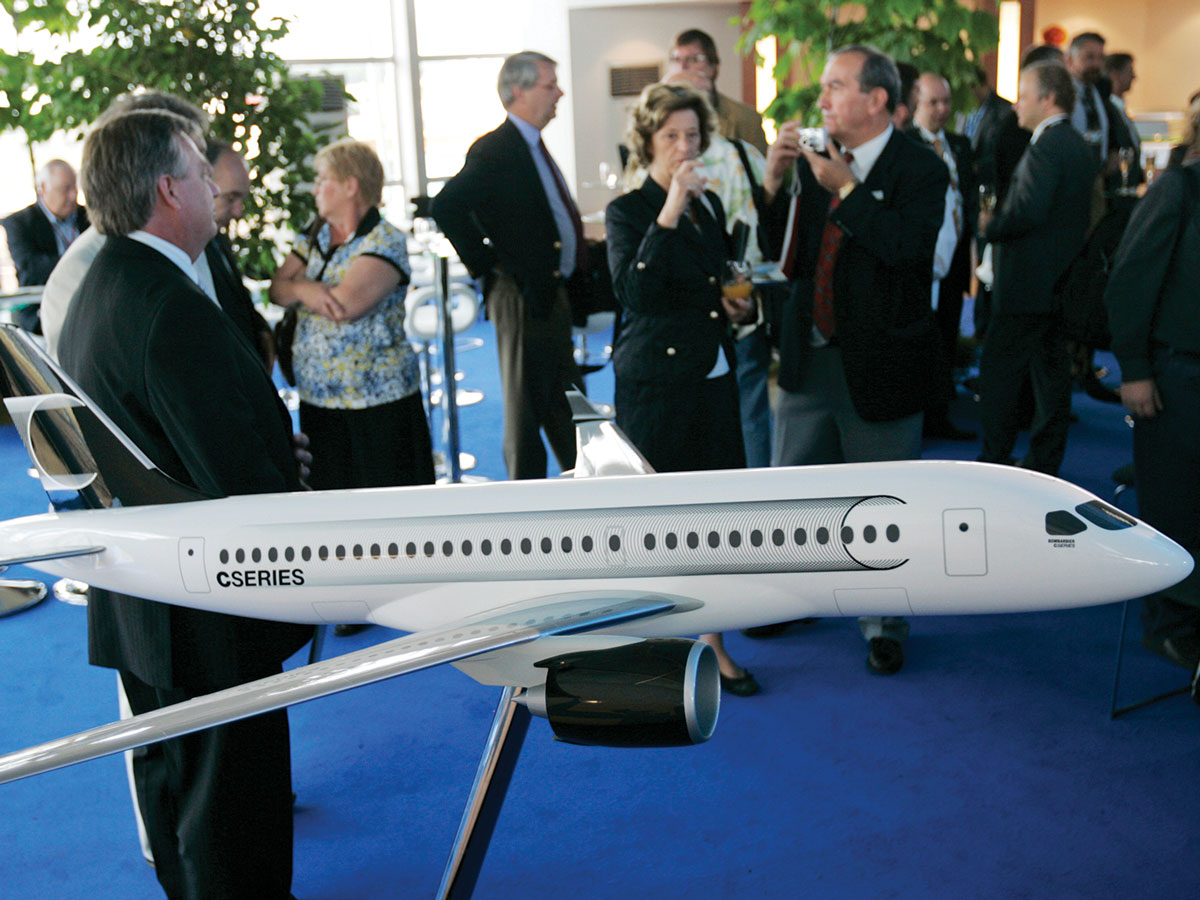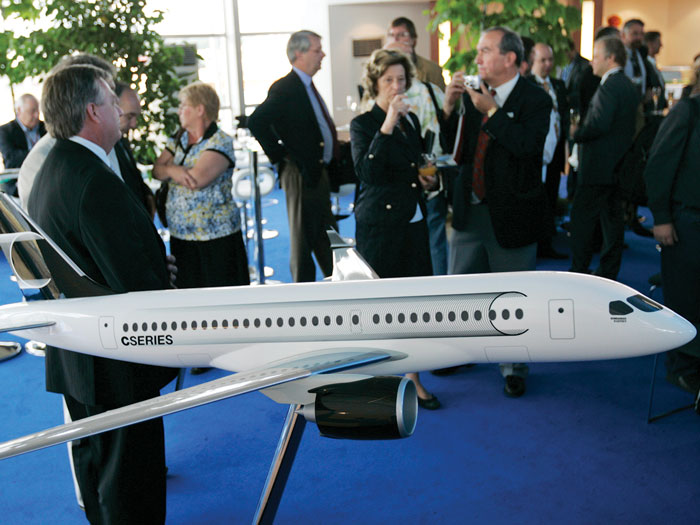
Bombardier’s C-Series is a huge hit . . . for Airbus
 Bombardier and Airbus partnered in 2017 on their C-Series program, including the jet pictured here (AP)
Bombardier and Airbus partnered in 2017 on their C-Series program, including the jet pictured here (AP)
Attention patriotic Canadian innovators: this is going to hurt.
At a splashy ceremony at Paris’ Charles de Gaulle Airport last year, dignitaries and corporate executives took turns lavishing praise on the Airbus A220 as Air France took possession of the first of the 60 148-seat passenger jets the airline has ordered.
“This new aircraft with an unparalleled energy performance represents a major asset for Air France,” gushed Benjamin Smith, CEO of Air France-KLM, pointing to its industry-leading reductions in emissions and fuel use. “It is not just any plane. It’s a new series of Airbus, an A220. And an A220 operated by Air France,” enthused Jean-Baptiste Djebbari, the French minister of transport. “In other words: the quintessence of French success and excellence.”
Truth be told, this quintessence of French success and excellence isn’t actually French at all. As recently as 2018, the A220 was known as the C Series jet. And, back then, it was the pride of Canadian innovation—a product conceived by a Canadian business titan, designed by Canadian engineers and heavily backed by Canadian taxpayers. And yet, despite the aircraft’s obvious competitive advantages, Montreal-based Bombardier was unable to sell its brilliant new idea to the world. Instead, it ended up selling the entire concept to a foreign company for a song.
Ouch.
The story of how Canada’s star-crossed C Series jets became the wildly successful Airbus A220—aka the glory of France—is a tale that lays bare this country’s chronic problems in the innovation economy. As a country, we habitually underinvest in R&D. And, when domestic champions like Bombardier do emerge, they often prove unable to turn their great ideas into commercially successful, globally dominant businesses. As Canada looks to capitalize on a host of new technological breakthroughs in the green economy, what lessons can we learn from this national humiliation? And how can CPAs help with the transition?
A BETTER MOUSETRAP
The C Series made its first public appearance in 2008 as a flightless mock-up at England’s Farnborough International Air Show. At the time, Bombardier vowed it would be a “game-changer” in the single-aisle commercial jet category. Given the company’s track record, there was little reason to doubt this claim.
“Two decades ago, Bombardier was Canada’s most global company,” says Karl Moore, a business professor at the Desautels Faculty of Management at Montreal’s McGill University. “Some of the Canadian banks might have been bigger, but none operated around the world like Bombardier did. And it was all built by Laurent Beaudoin, one of the world’s great entrepreneurs.”
Under CEO Beaudoin’s guidance, Bombardier grew from its modest roots as the inventor of the snowmobile to become a world player in planes, trains and recreational vehicles. The key to Beaudoin’s long string of successes, says Moore, was his willingness to “take on huge bets” on bold new products. Bombardier entered the aviation market in 1986 when it took over financially troubled Canadair from the Canadian government. It later gobbled up other struggling aircraft manufacturers to become a major player in corporate and small regional jets. The C Series was another of Beaudoin’s big bets.
The C Series addressed the global need for an efficient, narrow-bodied commercial jet with seating for 110 to 150 passengers. At the time, in 2010, says Addison Schonland, an analyst with AirInsight Group, airlines’ only options were to take existing planes, typically from Airbus and Boeing, and make them lighter and smaller. But when the number of seats on an aircraft is shrunk by 20 per cent, adds Schonland, the plane’s weight isn’t necessarily reduced by the same amount. “Shrinking an aircraft actually makes it less efficient.”
Starting with a clean sheet allowed Bombardier to outmaneuver the existing duopoly. Designed to make use of ultra-quiet, next-generation engines, the C Series promised a 20 per cent reduction in fuel consumption compared to its competitors. It was also packed with new technology and creature comforts for travellers, such as wider seats. “There was no question that they built a better mousetrap,” says Schonland. The problem with this mousetrap cliché is that it assumes if you build a better one, the world will beat a path to your door. That advice doesn’t necessarily apply to commercial jet aircraft.
UP IN THE AIR
While Beaudoin’s entrepreneurial expertise allowed him to spot a market opportunity and create a product to exploit it, his firm was unable to turn that advantage into commercial gain. “You need deep pockets to break into this industry,” says Moore. Due to delays and cost-overruns, Bombardier struggled to deliver a flight-certified version of the C Series. The company soon found itself facing a debt-induced cash crunch.
In response, Bombardier went looking for help from taxpayers. After taking a $4.1 billion write-down on the C Series program in 2015, the firm received a $1 billion equity injection from the Quebec government. Then, in 2017, it was handed a $372 million loan by the federal government. According to the Montreal Economic Institute, Bombardier has obtained $4 billion in total public funds since 1966.
Compounding these financial difficulties was the hostile response from Airbus and Boeing, who finally woke up to the technological threat posed by the C Series. Since airlines prize longevity and reliability above all else, Airbus’ strategy was to focus on Bombardier’s uncertain long-term prospects. John Leahy, the colourful former chief salesman for Airbus liked to call the C Series “a nice little plane” that was fated to become an “orphan” if (or when) Bombardier succumbed to its financial problems.
In a knowledge economy, a country’s future prosperity is increasingly tied to its ability to generate and capitalize on innovative new ideas.
Boeing took a different stance. In 2017, when the C Series appeared to be on the verge of breaking into the U.S. market, Boeing used Bombardier’s ample government aid as evidence for an anti-dumping claim that temporarily imposed a 300 per cent tariff on the plane. The tariff was eventually overturned but, by then, the damage had been done. In the summer of 2017, strapped for cash and at risk of having to shut down the entire program, Bombardier handed a majority share in the C Series to rival Airbus in exchange for development and marketing help. Two years later, Bombardier unloaded the rest of its stake for $600 million; the Quebec government retains a 25 per cent share in the program. A similar purge occurred with Bombardier’s train and regional jet businesses. Today, all that’s left of the once-mighty transportation conglomerate is a small but profitable corporate jet business.
Since being rebranded as the A220, however, the plane itself has suddenly become a roaring success. Airbus’ clout and reputation have countered any concerns airlines may have had about reliability or staying power. In 2017, the last year Bombardier fully controlled the C Series program, it managed to sell just 17 jets. By the summer of 2022, Airbus was crowing that its new plane had achieved a “breakthrough” in the market with 220 jets delivered and backorders for 760 more.
As for what remains of the once-wholly Canadian program, Airbus continues to make A220s at Bombardier’s former facility, now named Airbus Canada, at Mirabel Airport, although it also operates a much larger A220 factory in Mobile, Alabama. And there remains a cluster of aerospace firms in the Montreal area. Asked to sum up the entire experience, McGill’s Moore says, “It was a brilliant plane that all Canadians can take pride in. But Airbus is just a better parent for the program.” Besides pride in a job well done, what else should Canadians take away from the C Series story?
THE CANADIAN PARADOX
In a knowledge economy, a country’s future prosperity is increasingly tied to its ability to generate and capitalize on innovative new ideas. “Canada has all the right ingredients for innovation success,” observes Aidan Hollis, a University of Calgary economist. “We have a well-educated workforce, skilled researchers and access to government funding.” Yet a 2019 report for the Institute for Research in Public Policy by Hollis and University of British Columbia economist Nancy Gallini found Canada lags its international peers across numerous important metrics, including R&D expenditures, total number of researchers and patents obtained. The economists call this puzzling and disappointing state of affairs “a Canadian paradox.” Explains Hollis, “the paradox is that while there is innovation going on in Canada, we do not observe the same level of commercialization and ownership of those innovations [as in other countries]. In many cases, inventions developed in Canada are then commercialized by foreign companies that keep much of that benefit.”
It is often easier for inventors to sell out than do the tough work required to bring a new product or idea to market.
As the C Series saga demonstrates, there’s more to the problem than just a lack of R&D spending. While Gallini and Hollis’s data suggest Canadian firms generally underinvest in R&D, Bombardier broke this mold as it tried to enter the commercial jet market. From 2012 to 2018, the firm was Canada’s top spender on R&D, in some years spending more than double its next nearest competitor, which was often Blackberry, another ill-fated Canadian icon. And still it failed.
The same thing happens regularly on a much smaller scale throughout the Canadian economy. Gallini and Hollis also found a majority of Canadian-invented patents registered in the U.S. (where all significant international patents are filed) are actually owned by foreign firms. And many of these patents were developed with generous government support from programs such as the federal Scientific Research and Experimental Development (SR&ED) tax credit.
Why do so many good Canadian ideas end up in foreign hands? Hollis offers several reasons, most of which turn on the peculiarities of Canadian geography and economics. As a relatively small market next to the world’s largest, it is proportionately more difficult for Canadian firms to scale up to competitive size, he says. Plus, the many shared characteristics between Canada and the U.S. make it convenient for large American firms to poach Canadian talent and inventions. “If you are a U.S. company looking to expand your research base, Canada is close, accessible and culturally similar,” he notes. It is often easier for inventors to sell out than do the tough work required to bring a new product or idea to market.
While Hollis admits that every foreign sale of Canadian technology represents a payday for a Canadian entrepreneur, it also means “our intellectual brainpower is being harvested by foreign corporations. It would be better if we could have the benefit of those profits and head offices stay in Canada,” he says.
GREEN LESSONS
In its 2022 budget, the federal government announced plans to create an innovation and investment agency, taking its cues from Finland and Israel, which have used similar agencies to bring innovative new ideas to market. The government also announced a review of the broadly distributed SR&ED tax credit system with an eye to offering more targeted support. That is a move both Moore and Hollis back. But adopting this type of government aid requires a plan for what industries and companies to target.
With huge interest in positioning Canada’s economy to take advantage of new green technology, it's here that the C Series tale may be the most instructive. While it reveals that lavish government support and an ample R&D budget do not necessarily guarantee success, it’s important to remember that the commercial aircraft market has many unique features that create high barriers to entry. Other advanced sectors might be more welcoming to Canadian-sized innovation.
One possibility is electric vehicles, an area of recent and intense federal and provincial government attention. “There is tremendous room for Canada to be a leader here,” advises Peter Hatges, national automotive sector leader at KPMG in Canada. He points to the many new technologies in play across the industry, covering everything from batteries to autonomous-driving software. “There is a fundamental change occurring in the auto industry and Canada has an opportunity to participate on par with everyone else.”
 Canada is well-positioned to take advantage of opportunities to innovate within the electric vehicle market (Getty Images)
Canada is well-positioned to take advantage of opportunities to innovate within the electric vehicle market (Getty Images)
Hatges suggests the evolving automotive industry may offer a better route to success than the duopolistic commercial aircraft business since it is “the closest thing you can get to a free market with many, many producers.” The breadth of the existing supply chain means a single good Canadian idea does not have to outcompete global giants; rather, many Canadian firms are already valuable partners within an interconnected global network.
Breaking out of the Canadian paradox will also require a fundamental change in mindset across the country’s venture capital ecosystem, advises CPA Canada chief economist David-Alexandre Brassard. “Canada is very good at the status quo,” he says, pointing to our prodigious investments in housing and commercial real estate as examples of this safe approach. “But as a result, many new sectors that will be much more important to our future are getting overlooked.” Banks, pension funds and other major investors need to adjust their risk profiles to embrace these new opportunities, he says. It is a process that CPAs, with their expertise in evaluating risk and assessing different growth paths, are well positioned to embrace. “In many cases, the valuation goes beyond simple revenue and expenditure measures,” Brassard adds. “In emerging sectors there are many intangibles that must be taken into account and that requires specialized knowledge.”
Brassard also supports the federal review of the SR&ED program, noting that the program must be modernized to encourage innovation. Rather than act as an incentive to innovate, he says they’ve become so commonplace and easily accessed that most firms consider them just another recurring budget item. “We need to create better incentives,” he stresses, pointing to the tech and health care sectors as potential growth areas for Canada
Avoiding a repeat of the C Series situation means finding ways to bolster and scale-up Canadian technologies that don’t waste taxpayer support or allow other countries poach our best inventions. “We need to develop an infrastructure that is more conducive to growth,” advises KPMG’s Hatges, recommending a close look at taxes, labour and energy availability as well as government funding mechanisms. “But,” he warns, “you still need a good idea to start with.”
KEEP READING
Learn about the CPA betting big on Canada’s future as a crypto leader and the fintech innovation happening across the country. Plus, see how these CPAs are shaping the comebacks at Cirque du Soleil and the CFL.